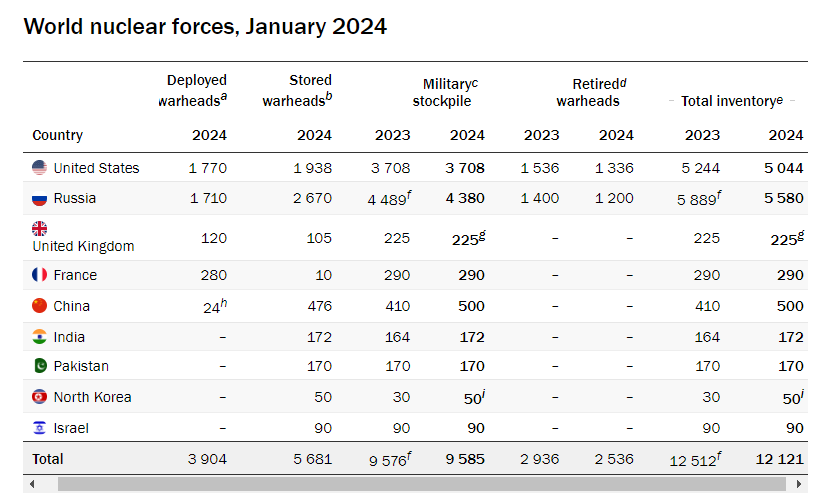
The Stockholm International Peace Research Institute (SIPRI) released its highly anticipated 55th edition of the SIPRI Yearbook 2024 on 17 June 24. This comprehensive yearbook, a cornerstone in the field, presents the institute’s annual evaluation of the state of armaments, disarmament, and international security, with a specific focus on nuclear threats and challenges.
Key findings of the SIPRI Yearbook 2024 are that the number and types of nuclear weapons in development have increased as states deepen their reliance on nuclear deterrence.
Relevant Excerpts
The nine nuclear-armed states are the United States, Russia, the United Kingdom, France, China, India, Pakistan, the Democratic People’s Republic of Korea (North Korea) and Israel. The nuclear countries continued modernising their nuclear arsenals, and several deployed new nuclear-armed or nuclear-capable weapon systems in 2023.

Of the total global inventory of an estimated 12,121 warheads in January 2024, about 9585 are in military stockpiles for potential use. An estimated 3904 of those warheads are deployed with missiles and aircraft; the rest are in central storage. Around 2100 deployed warheads are kept in a high operational alert on ballistic missiles. Nearly all of these warheads belonged to Russia or the USA, but for the first time, China is believed to have some warheads on high operational alert.
While the global total of nuclear warheads continues to fall as Cold War-era weapons are gradually dismantled, regrettably, there is a year-on-year increase in the number of operational nuclear warheads.
India, Pakistan, and North Korea are all pursuing the capability to deploy multiple warheads on ballistic missiles, something Russia, France, the UK, the USA and—more recently—China already have.
Russia and the USA together possess almost 90 percent of all nuclear weapons. The sizes of their respective military stockpiles (i.e., useable warheads) seem to have remained relatively stable in 2023. In addition to their military stockpiles, Russia and the USA each hold more than 1200 warheads previously retired from military service, which they are gradually dismantling.
Russia. Russia is estimated to have deployed around 36 more warheads with operational forces than in January 2023. Transparency regarding nuclear forces has declined, and debates around nuclear-sharing arrangements have increased in saliency. Notably, there were several public claims made in 2023 that Russia had deployed nuclear weapons on Belarusian territory. However, there is no conclusive visual evidence that the actual deployment of warheads has taken place.
China. SIPRI’s estimate of the size of China’s nuclear arsenal increased from 410 warheads in January 2023 to 500 in January 2024, and it is expected to keep growing. For the first time, China may also now be deploying a small number of warheads on missiles during peacetime. Depending on how it decides to structure its forces, China could potentially have at least as many intercontinental ballistic missiles (ICBMs) as either Russia or the USA by the turn of the decade. However, its stockpile of nuclear warheads is still expected to remain much smaller than the stockpiles of either of those two countries.
United Kingdom. Although the UK is not thought to have increased its nuclear weapon arsenal in 2023, its warhead stockpile is expected to grow in the future due to the British government’s announcement in 2021 that it was raising its limit from 225 to 260 warheads. The government also said it would no longer publicly disclose its quantities of nuclear weapons, deployed warheads or deployed missiles.
France. In 2023, France continued its programmes to develop a third-generation nuclear-powered ballistic missile submarine (SSBN) and a new air-launched cruise missile and refurbish and upgrade existing systems.
India. In 2023, India slightly expanded its nuclear arsenal and continued developing new nuclear delivery systems. India appears to be placing growing emphasis on longer-range weapons, including those capable of reaching targets throughout China.
North Korea. North Korea continues to prioritise its military nuclear programme as a central element of its national security strategy. SIPRI estimates that the country has now assembled around 50 warheads and possesses enough fissile material to reach a total of up to 90 warheads, both significant increases over the estimates for January 2023. While North Korea conducted no nuclear test explosions in 2023, it appears to have carried out its first test of a short-range ballistic missile from a rudimentary silo. It also completed the development of at least two types of land-attack cruise missiles (LACM) designed to deliver nuclear weapons.
Israel. Israel does not publicly acknowledge possessing nuclear weapons. It seems to be modernising its nuclear arsenal and upgrading its plutonium production reactor site at Dimona.
Global Security and Stability in Peril
The impacts of the wars in Ukraine and Gaza are visible in almost every aspect of the issues connected to nuclear, armaments, disarmament and international security.
Increasing Reliance on Nuclear Deterrence. Russia has continued to make threats regarding the use of nuclear weapons in the context of Western support for Ukraine. In May 2024, Russia carried out tactical nuclear weapon drills close to the Ukrainian border.
Setback to Nuclear Arms Control and Disarmament. Nuclear diplomacy suffered more significant setbacks in 2023.
-
- In February 2023, Russia announced it was suspending its participation in the 2010 Treaty on Measures for the Further Reduction and Limitation of Strategic Offensive Arms (New START)—the last remaining nuclear arms control treaty limiting Russian and US strategic nuclear forces. The USA also suspended the sharing and publication of treaty data as a countermeasure.
-
- In November, Russia withdrew its ratification of the Comprehensive Nuclear-Test-Ban Treaty (CTBT), citing ‘an imbalance’ with the USA, which has failed to ratify the treaty since it opened for signature in 1996. However, Russia confirmed it would remain a signatory and continue participating in the Comprehensive Nuclear-Test-Ban Treaty Organization (CTBTO) work.
-
- An informal agreement reached between Iran and the USA in June 2023 seemed to temporarily de-escalate tensions between the two countries, which had intensified over Iran’s military support to Russian forces in Ukraine. However, the start of the Israel–Hamas war in October upended the agreement, with proxy attacks by Iran-backed groups on US forces in Iraq and Syria ending Iranian–US diplomatic efforts.
-
- The war also undermined efforts to engage Israel in the Conference on the Establishment of a Middle East Zone Free of Nuclear Weapons and Other Weapons of Mass Destruction.
Comments
-
- While global nuclear destructive power is stable (if not decreasing) for the time being, the increase in the number of warheads on high op alert is a cause of concern. The number of warheads deployed on missiles and aircraft shows an upward trend.
-
- The capability to deploy multiple warheads on missiles would enable a rapid potential increase in deployed warheads, as well as the possibility for nuclear-armed countries to threaten the destruction of significantly more targets.
-
- Several nuclear-armed states are putting new emphasis on developing their arsenal of tactical nuclear weapons. The concern is about the early use of these weapons in a conflict.
-
- Given that the USA and Russia possess 90% of the total global nukes, the Ukraine conflict (Russia – NATO/West conflict in a broader sense) is not safe. Reduction in their stockpile will make the world safer.
-
- China is expanding its nuclear arsenal faster than any other country. China deploying nuclear warheads on missiles on op alert indicates a strategic shift and a possible change in its nuclear policy.
-
- Pakistan’s nuclear arsenal has shown no change in numbers. However, Pakistan, too, has advanced its nuclear delivery systems. Considering its internal conditions and prevailing geo-political situation, fear of its nuclear weapons falling into the wrong hands remains.
-
- The gradual reductions in nuclear stockpiles that characterised the post-Cold War period are over, and the world is sliding back into nuclear competition and arms race.
-
- Cold War II has enhanced nuclear capabilities, reduced nuclear transparency, and increased reliance on nuclear deterrence.
-
- The world is slowly moving one step closer to the speedier initiation of a nuclear exchange.
-
- Launch due to accidental firing, miscalculation, or foolhardiness is worrisome. Mutually acceptable safety measures need to be implemented on priority.
-
- Adequate security measures must be instituted to avoid these launch-ready weapons falling into the hands of non-state actors.
-
- Nuclear weapons are once again (like in the Cold War era) playing a prominent role in international relations. Despite two years back, leaders of the five largest nuclear-armed states jointly reaffirmed that “a nuclear war cannot be won and must never be fought”.
-
- Recent developments demonstrate the fragile nature of Nuclear Arms Control and Disarmament treaties. Fresh impetus is required to maintain the relevance of measures taken for Nuclear Disarmament:-
-
- Treaty on the Prohibition of Nuclear Weapons 2017 prohibits the development, testing, production, acquisition, possession, or use of nuclear weapons.
-
- The Treaty on the Non-Proliferation of Nuclear Weapons (NPT) 1968 aims to prevent the spread of nuclear weapons, promote cooperation in peaceful uses of nuclear energy and achieve nuclear disarmament.
-
- Comprehensive Test-Ban Treaty (CTBT), 1996, prohibits nuclear weapon tests in the atmosphere, outer space, and underwater.
-
- The world is now in one of the most dangerous periods. Numerous sources of instability (political rivalries, economic inequalities, and ecological disruption) encourage and accelerate an arms race.
-
- It is time for the nuclear powers and the multi-lateral organisations to step back and reflect together.
Addendum
India’s Nuclear Policy. India has adhered to a nuclear no-first-use (NFU) policy since 1999. The country’s stated doctrine from January 2003 includes a pledge not to use nuclear weapons first but with a significant caveat that nuclear weapons could be used if Indian forces are attacked with biological or chemical weapons. India reaffirmed in 2018 that it could also use nuclear forces to retaliate against attacks by non-nuclear weapons of mass destruction (WMD).
Recent Developments. In November 2019, India formally declared the operationalisation of its nuclear triad after the country’s first SSBN, INS Arihant, completed its first deterrence patrol. In March 2024, India successfully conducted “Mission Divyastra” by launching Agni-V with multiple independently targetable re-entry vehicle (MIRV) technology. This placed India into a club of the few countries capable of delivering multiple nuclear warheads using a single missile.
Suggestions and value additions are most welcome.
For regular updates, please register here:-
References and credits
To all the online sites and channels.
- SIPRI Year Book 2024.
- Eliana Johns, “We’re Entering A New Period”, Federation of American Scientists, 17 Jun 24.
- https://currentaffairs.khanglobalstudies.com/sipri-yearbook-report-2024/
Disclaimer:
Information and data included in the blog are for educational & non-commercial purposes only and have been carefully adapted, excerpted, or edited from reliable and accurate sources. All copyrighted material belongs to respective owners and is provided only for broader dissemination.










